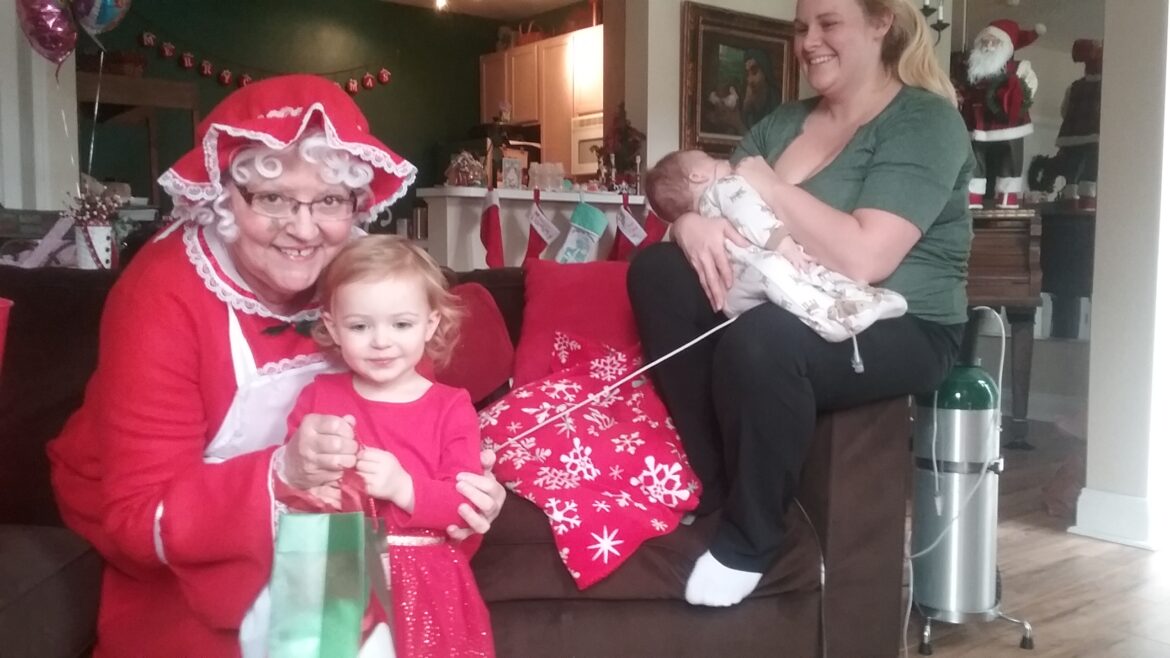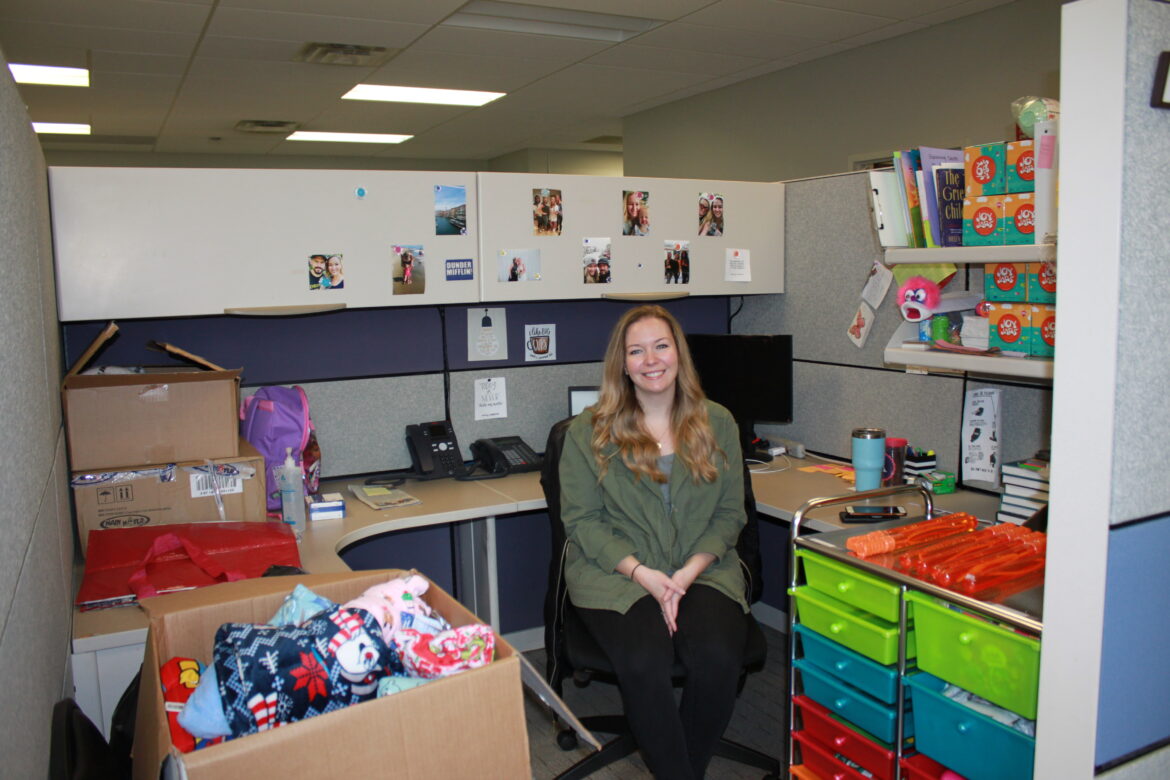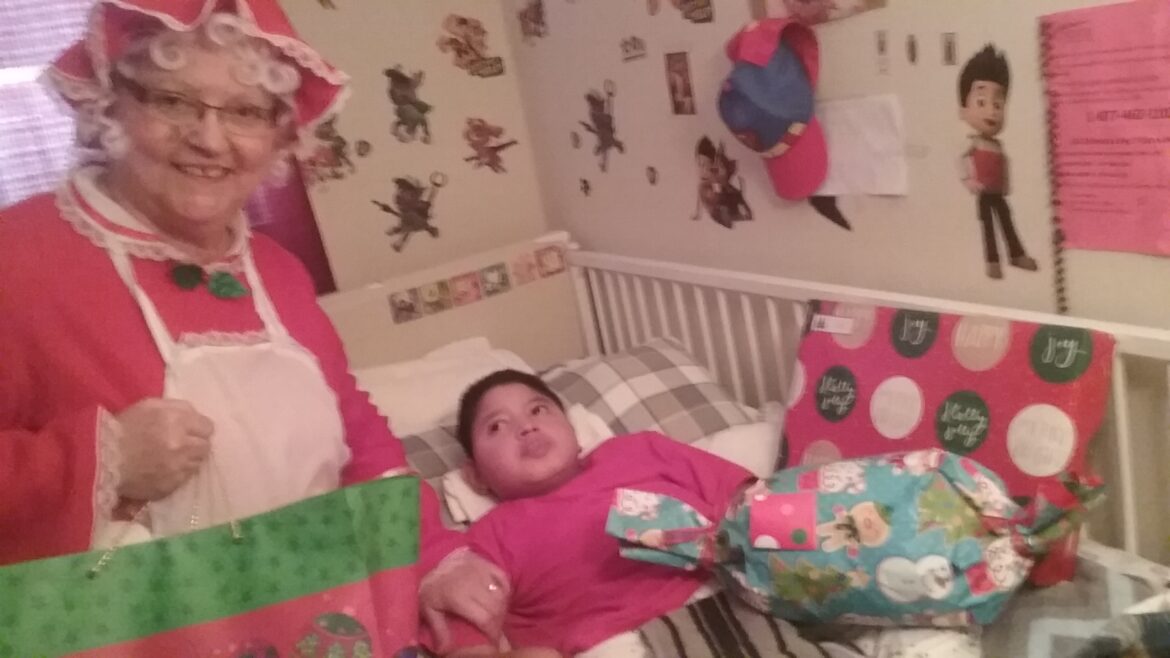
Hospice of the Chesapeake Volunteer Alice Jo Weaver, dressed as Mrs. Santa, to deliver gifts to a pediatric hospice family .
We have heard much about school systems going online as opposed to in physical classrooms. For the most part, we all understand the reason behind it but parents wonder how they can continue to work while also helping their children learn in a home setting that was never meant to be a classroom. Now, imagine that one of those children is a pediatric hospice patient with a life-limiting illness. It’s like weathering two storms.
The job of raising a child who requires round-the-clock care is already more than most adults could handle. Along with frequent visits to see physicians and a daily regimen that involves medications, feeding tubes, therapies, and coordinating resources they now must manage the in-home education of other children along with the complicated requirements of getting to medical centers that are restricting access due to the pandemic.
This year has highlighted how important the Chesapeake Kids program is for these families. When it comes to a child who has a life-limiting illness or condition, you cannot care for the whole patient without caring for the whole family. It takes a pediatric hospice interdisciplinary team that includes a physician, nurse practitioner, registered nurse, social worker, chaplain and certified child life specialist. Also helping the team are specially trained counselors, integrative art therapists and dedicated volunteers.

Hospice of the Chesapeake Child Life Specialist Alex Haarich sits in her cubicle surrounded by the tools and resources she needs to help pediatric hospice families in the Chesapeake Kids program.
This team works directly with the families’ primary care physicians and specialists to add an additional layer of support that is focused on quality of life, again, not just for the patient but for the whole family. Child Life Specialist Alex Haarich said that an integral part of our service is supporting families who are actively seeking a cure for their child, including radiation, chemotherapy and other life-saving treatments. “A lot of times people don’t know that when pediatric patients are on a hospice service, they can continue to seek curative treatments and therapies,” Haarich said. “We tell families all the time that joining hospice is not giving up hope. It just ends up being a change in their goals.”
Of course, there are children who are dying, which makes one aspect of the team’s job especially important — memory-making and legacy-building with the family. This includes documenting their time together and creating keepsakes to honor their memory. When this article was written, the team was planning for its annual Children’s Memorial ceremony for Hospice of the Chesapeake families who have lost a child. Traditionally held on campus, this year’s event was privately held online.
Haarich’s role crosses disciplines as she also supports the Chesapeake Life Center by facilitating its pre-teen and teen grief support groups, which continued online during the coronavirus shutdown. She was one of the faces seen and voices heard on the Zoom gallery view during Grief Burst 2020!, the center’s first ever virtual grief camp held in August. Now she and the team are gearing up for their Days of Joy holiday sharing program. Last year, eight families benefitted from the generosity of donors who provided festively wrapped gifts for all the members of each family that were delivered to their homes. That will be even more important this year as extended families may not be able to celebrate in person.
A lot of times people don’t know that when pediatric patients are on a hospice service, they can continue to seek curative treatments and therapies. We tell families all the time that joining hospice is not giving up hope. It just ends up being a change in their goals.
Like all of Hospice of the Chesapeake’s services, Pediatric Program Coordinator Laura Smith said the pandemic has required her team to change the way they care for their patients. The care plan includes virtual visits, checking in by phone and adapting in-home visits with a balance that matches each families’ comfort level. She said that having to wear personal protective equipment creates some mental and physical barriers when meeting with a new family, talking to a small child or having difficult conversations with parents and siblings. “Especially when meeting with new families I try to have them see my face when I am still on their porch before I gear up before coming inside,” Smith said.
Bring some holiday hope to a pediatric family this year. To adopt a family in our Days of Joy holiday sharing program, please contact foundation@hospicechesapeake.org or call 443-837-1527.

Hospice of the Chesapeake Volunteer Alice Jo Weaver, dressed as Mrs. Santa, to deliver gifts to Diego Medrano Alvarado and his family.


